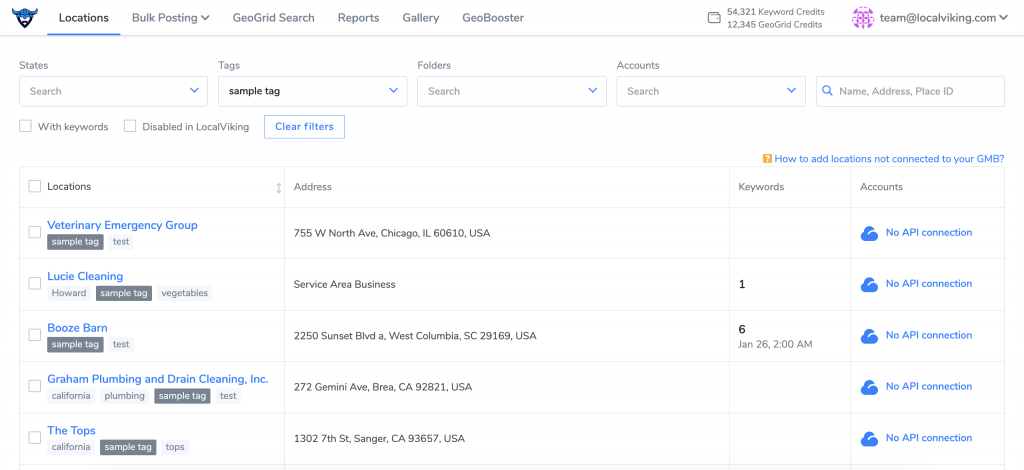Greetings, readers. We have an announcement to start today’s newsletter. Our CTO, Nate, will be hosting another AMA session on Wednesday. You can register for it here. Participants are welcome to ask about local SEO, marketing, our GeoBooster mobile app– you can ask about anything, really. It’s up to you. This will be the fourth one of these we’ve done and they’ve all been a good time. Join us.

We mentioned last week that Local Viking and Local Brand Manager now show tags on the locations page. Clicking on a tag will produce a list of all locations belonging to it. We have an update to that feature that belongs on the Mount Rushmore of human achievement (next to the invention of writing, mankind’s mastery of fire, and the agricultural revolution): the tags now get highlighted when you click them. We apologize to anyone with a heart condition who had trouble processing something this revolutionary.
In all seriousness, Local Viking and Local Brand Manager are on the verge of deploying a dizzying array of incredibly useful new features. Nate’s talk on February 1 will go over the status of things like video posting and our upcoming auditing functionality. He’ll also spend some time showcasing our embeddable GeoBooster widget that allows the posting of geotagged images with algorithm-tickling captions on any website.
Moving on, we’ve learned new details about a story we mentioned last week– the one that discussed hackers buying ads for donation-supported software to place virus-laden websites atop Google search results pages. We mentioned that such ads mostly target people seeking freeware programs like VLC and gimp (among plenty of others). What we were unaware of last Friday is the fact that these bad actors also used a program called MSI Afterburner as malware bait.
Afterburner is virtually unknown to people with friends, but a segment of the cryptocurrency crowd is quite familiar with it. It’s software that allows people to overclock the expensive, high-end graphics cards that are critical for mining bitcoin and many lesser-known tokens. This made Afterburner phishing sites perfect vectors for surreptitiously delivering malicious code that located and liquidated crypto wallets.
The total number of victims is unknown. The good news is that more and more people are becoming wise to this scheme. Millions of Twitter users saw this thread detailing a heartbreaking ordeal that someone with the sympathetic username @NFT_GOD suffered through after he installed the software he found when searching Google for OBS, an open-source livestreaming application.

Google is ordinarily ferocious when it comes to protecting its ad business, making the broader problem of hacking tool-containing websites sneaking through the approval process pretty baffling. People find the situation so confusing that the FBI now recommends using an ad blocker when conducting internet searches (read the third bullet point in the image above this paragraph). It’s hard to describe how wild that is. The federal government does not frequently advise practices that deprive large domestic corporations of their primary revenue source.
If any of you are between jobs or looking to jump ship, the good news is that many marketing agencies are hiring. This Marketing Brew article explains which roles are currently the most highly-demanded. If you’re not sure about how much compensation to ask for, this page on comparably.com has reliable average salary data.

The final thing we’ll talk about this week is how much hype surrounds ChatGPT. Microsoft is in the news because of its multibillion-dollar investment in OpenAI, ChatGPT’s creator. Trying not to get left in the dust, the main story on Google’s blog right now is 9 Ways We Use AI In Our Products. Even Avocados From Mexico put out a press release to tell the public it plans to use ChatGPT in its upcoming Super Bowl ad. Cool.
It’s time to calm down about ChatGPT. Yes– it’s definitely cool. We play with it all the time (probably too much, honestly). The thing to realize is that today’s AI projects still need a lot of effort before they’ll be considered accurate and reliable enough for various industries to truly depend on. The majority of you probably have at least 12-18 months before you’ll get replaced in the workplace, so let’s all just take a chill pill already.
(Hopefully) We’re joking. Who knows what the future holds? Not us. We’ll be glad to see a lot of you folks on Wednesday for Nate’s talk. Otherwise, you’ll hear from us again in February. Take care of yourselves out there.